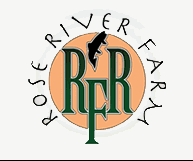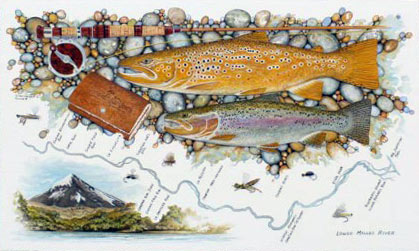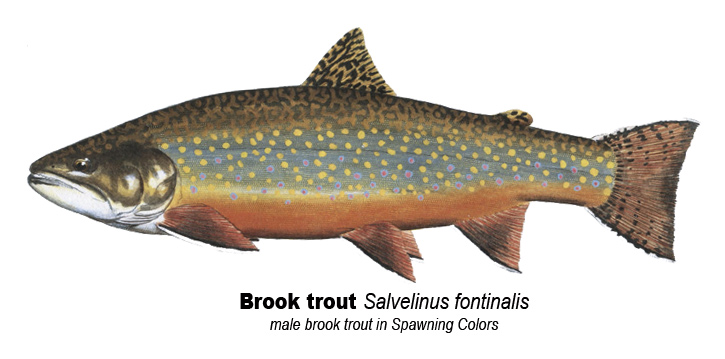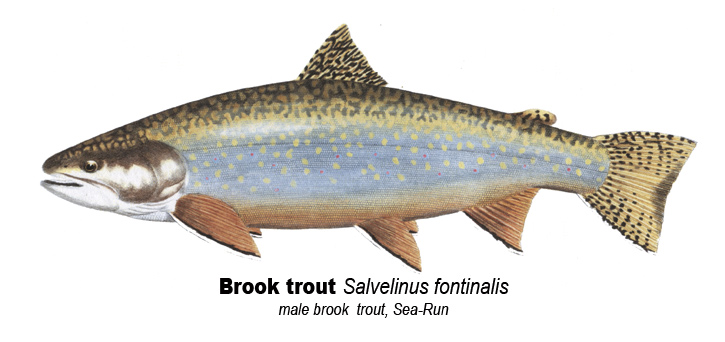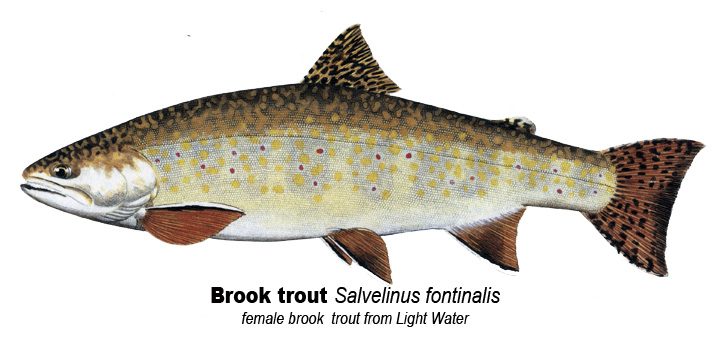Brook Trout
Salvelinus fontinalis
Local Names:
Brookie, Brook char, Speckled trout, Squaretail, Salter, Sea-trout
Average Size:
6 to 12 inches
0.25 to 0.75 pounds
Distinguishing Field Marks:
Color and color pattern are reliable distinguishing field marks for this species. (See the illustrations.)
-
Brook trout from different regions and water types will show distinctive colors and patterns (see the accompanying illustrations).
-
Like all chars, Brook trout have light markings on a dark background.
-
The worm-like vermiculations on a Brook trout's back are usually enough to distinguish it from other species.
-
The mouth is large, with the upper jaw extending well beyond the rear edge of the eye.
-
There are dark (usually black) wavy markings on the dorsal, adipose, and tail (caudal) fins.
-
The upper and lower edges of the tail may be lined with white or cream color.
-
The anal, pelvic, and pectoral fins usually have pure white leading edges outside of a narrow black band.
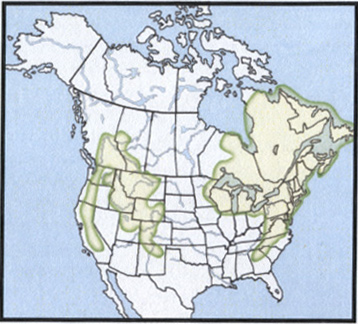
North American Range:
Map to the right shows approximate range in North America.
Biology:
Brook trout generally spawn in the fall, late September, October, and November. Males develop elongated upper and lower jaws and become very intensely colored, females less so.
The females select and excavate nest sites, in shallow fine gravel-bottom riffles, and also in shoal water of lakes or ponds, with males jockeying for position and occasionally charging one another. Egg counts range from 100 to 5,000. Depending on conditions, the eggs hatch in as little as 50 to as many as 100 days. The alevins remain in the nest gravel absorbing the yolk sac and then swim-up as fry.
Brook trout often spend their entire lives in the streams of their birth, although some return downstream as young adults and enter ponds, lakes, or the ocean. Those that remain in small cold water streams usually do not grow to more than 6 or 8 inches. Those that live in lakes or large ponds may achieve lengths from 18 to 24 inches and weights from 5 to 8 pounds. Brook trout do not live long lives, usually from 4 to 8 years.
Diet:
Zooplankton, graduating to aquatic insects and other invertebrates. Brook trout are opportunistic omnivores and will take a wide range of foods as they are available. Large brook trout feed extensively on forage fish, showing a preference for sculpins. Dan Gapen originated the now widely used Muddler Minnow fly pattern to imitate a sculpin species on which he had found Canadian Brook trout selectively feeding.
Fly Fishing for Brook Trout:
Brook trout have been widely introduced beyond their native eastern range and are now nearly as wide ranging as Rainbow trout. Where they remain native or have been established through stocking, locating small to medium sized Brook trout should only require an angler's seeking the up-stream tributaries of larger rivers, or checking with local tackle shops, outfitters, and guides to find them in larger bodies of water. Brown trout were brought to this country to supplant the native Brook trout as their numbers were diminished by development, pollution, timber harvesting, and over-fishing. Since they do well only in pure cold-water often remote habitats with no other species for competition, Brook trout are easily displaced. Interestingly, this same species that was driven out of many of its historic habitats has done quite well when stocked in western streams and lakes, but have done so by displacing several native western trout species.
These seemingly always hungry chars will come to nearly any angler's offering. Streamer flies, nymphs, wet flies, and dries will all bring Brook trout to the hook. Searching fly patterns in all forms and sizes are a good approach to fly fishing for Brook trout as they tend not to be hook or leader-shy. Spring and fall, when the water is cool, are the best times to fish for Brook trout. In the warmer months they will congregate around spring seeps and into deeper water in ponds and lakes.
Very light fly tackle, in the 3 to 4 weight class outfits with as short as 6 or 7 foot rods may be necessary for getting into small brushy streams that may hold hundreds of wild Brook trout. For larger waters, fly fishing equipment in the 5 to 7 weight class is appropriate.
Significance to Humans:
Although they are not true trout, Brook trout were the first North American “trout” that Caucasian settlers encountered when they began fishing these waters. They found them easy to catch, and many complained bitterly when the more challenging Brown trout was introduced to replace them.
Status:
Maintaining, through some natural reproduction and often through annual stocking, the Brook trout’s range is being expanded through introductions.


